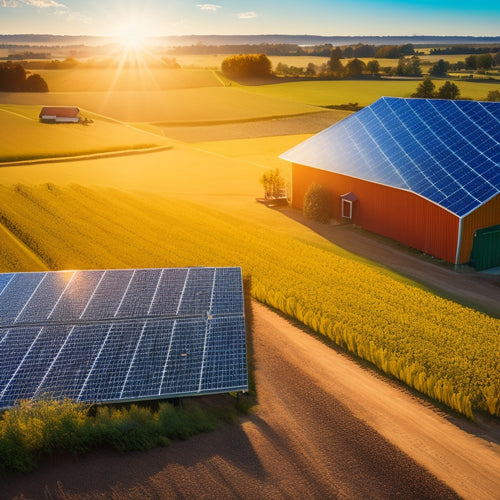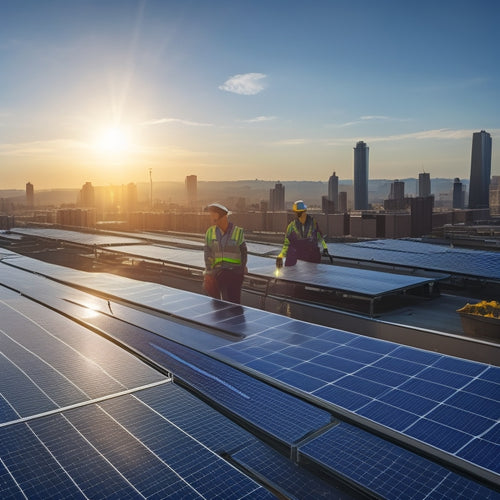
Does Your Industry Need Industrial Solar Installation Now
Share
As you weigh the costs of traditional energy sources, you're likely considering the benefits of industrial solar installation. With decreased solar panel costs, you can optimize energy usage, reduce waste, and minimize risks associated with fluctuating energy prices. By adopting solar energy, you'll not only position your industry ahead of competitors but also enhance business resilience. With government incentives and policies supporting renewable energy adoption, now's the time to investigate how industrial solar installation can future-proof your business operations - and uncover the specific advantages that can change your industry's energy environment.
Key Takeaways
- Industrial solar installation offers cost savings, energy efficiency, and price stability, making it a viable option for industries amidst rising energy costs and inflation.
- Adopting solar energy can position industries ahead of competitors, enhance business resilience, and support sustainable practices.
- Renewable energy sources like solar power can mitigate the environmental impact of industries, reducing greenhouse gas emissions and resource depletion.
- Government incentives and policies, such as tax credits and renewable energy certificates, make industrial solar installation more attractive and economically viable.
- Embracing industrial solar installation can future-proof business operations, ensuring a sustainable and competitive edge in the long run.
Understanding Industrial Solar Benefits
Understanding Industrial Solar Benefits
Your organization's adoption of industrial solar installation can bring numerous benefits, making it an attractive option for companies seeking to reduce their environmental footprint and improve their bottom line.
One significant advantage is the potential for substantial cost savings. With solar technology advancements, the cost of solar panels has decreased, making it more feasible for industries to integrate solar energy into their operations. This can lead to reduced energy expenditure, freeing up resources for other business-critical areas.
Additionally, industrial solar installation can increase industrial energy efficiency, allowing your organization to optimize its energy usage and reduce waste. By leveraging solar power, you can also mitigate the risks associated with fluctuating energy prices, ensuring a more stable financial future.
Moreover, industrial solar installation can enhance your organization's reputation, demonstrating a commitment to sustainability and social responsibility. By embracing industrial solar, you can stay ahead of the competition and reap the rewards of a more sustainable and cost-effective energy strategy.
Environmental Impact of Industries
As you investigate the benefits of industrial solar installation, it's equally important to acknowledge the significant environmental impact of industries. Your industry's operations likely contribute to greenhouse gas emissions, resource depletion, and waste generation, which can have devastating effects on biodiversity and ecosystems.
To mitigate these impacts, it's vital to adopt sustainable practices, such as implementing renewable technologies like solar power, reducing your carbon footprint, and promoting eco-friendly materials. Effective waste management and resource conservation strategies are also important in minimizing your industry's environmental footprint.
Additionally, conducting a lifecycle assessment can help identify areas for improvement and optimize your operations to guarantee corporate responsibility. Complying with environmental regulations isn't only a legal obligation but also a moral imperative.
Rising Energy Costs and Inflation
Ramping up your energy expenses is a harsh reality you're likely facing, with rising energy costs and inflation taking a considerable toll on your industrial operations.
The increasing costs of traditional energy sources are eating into your profit margins, making it essential to investigate alternative solutions that can help you stay competitive.
Industrial solar installation can be a transformative element in this scenario. By utilizing the power of the sun, you can considerably reduce your reliance on traditional energy sources, leading to substantial cost savings.
Additionally, solar energy is a clean and renewable source, which means you'll be contributing less to greenhouse gas emissions and supporting a more sustainable future.
Dependence on Fossil Fuels Decreases
You're shifting away from fossil fuels and embracing renewable energy adoption, which reduces your reliance on finite resources and mitigates the impact of price volatility.
By adopting cleaner power sources, you're not only decreasing your carbon footprint but also contributing to a more sustainable future.
As you decrease your dependence on fossil fuels, you'll find that industrial solar installation becomes an increasingly attractive option for powering your operations.
Renewable Energy Adoption
The global energy landscape is undergoing a significant change, with renewable energy sources gradually supplanting fossil fuels as the preferred choice for power generation. As you maneuver through this shift, you're likely considering the role industrial solar installation can play in your industry's energy transformation.
| Renewable Energy Source | Global Share of Electricity Generation |
| Solar Power | 3.3% (2020), 15.5% (projected 2030) |
| Wind Power | 6.5% (2020), 24.3% (projected 2030) |
| Hydroelectric Power | 15.6% (2020), 14.2% (projected 2030) |
| Geothermal Power | 0.3% (2020), 0.5% (projected 2030) |
| Biomass Power | 2.2% (2020), 3.1% (projected 2030) |
You're not alone in this energy transformation. Governments and corporations worldwide are investing heavily in solar technology to reduce their reliance on fossil fuels. By adopting renewable energy sources, you can decrease your industry's carbon footprint, mitigate the risks associated with price volatility, and position yourself for long-term sustainability. As you consider industrial solar installation, it's crucial to weigh the benefits of renewable energy adoption against the costs of maintaining the status quo.
Cleaner Power Sources
As renewable energy sources gain traction, industries are shifting away from fossil fuels, driving a considerable decrease in dependence on these polluting power sources.
You're likely aware of the environmental benefits, but did you know that cleaner power sources can also improve your bottom line?
Here are some key benefits of moving to cleaner power sources:
-
Reduced energy costs: Solar technology and energy efficiency measures can greatly lower your energy expenditure.
-
Increased energy independence: By generating your own power, you're less reliant on the grid and less exposed to price volatility.
-
Enhanced brand reputation: Committing to cleaner power sources demonstrates your commitment to sustainability, enhancing your brand's reputation and appeal.
- Compliance with regulations: As governments increasingly implement policies to reduce carbon emissions, shifting to cleaner power sources can help you stay ahead of regulatory requirements.
Government Incentives and Policies
With governments worldwide recognizing the urgent need to shift to renewable energy sources, policies and incentives have emerged to facilitate the adoption of industrial solar installations. You're likely aware that the shift to clean energy isn't solely driven by environmental concerns, but also by economic benefits. Governments are now offering attractive incentives to encourage businesses to invest in industrial solar installations.
| Country | Incentive | Description |
|---|---|---|
| USA | Solar Tax Credits | 30% tax credit on the total cost of a solar installation |
| Australia | Renewable Energy Certificates | Certificates can be sold to generate additional revenue |
| Germany | Feed-in Tariffs | Fixed price per kWh for electricity fed into the grid |
| China | Renewable Portfolio Standards | Utilities must generate a certain percentage of electricity from renewables |
| India | Accelerated Depreciation | 80% depreciation in the first year, reducing tax liability |
These policy structures and incentives can greatly reduce the upfront costs of industrial solar installations, making them more viable for your business. By taking advantage of these incentives, you can not only contribute to a cleaner environment but also enjoy the financial benefits that come with it.
Renewable Energy for Sustainability
You're likely aware that industrial solar installations rely on green energy sources, such as solar power, wind power, and hydro power, to reduce carbon emissions and mitigate climate change.
As you investigate renewable energy for sustainability, you'll need to take into account energy storage solutions, like batteries and fuel cells, to guarantee a stable and reliable power supply.
Green Energy Sources
They're turning to green energy sources to reduce their reliance on fossil fuels and mitigate climate change. As you consider industrial solar installation, it's crucial to understand the importance of green energy sources in the shift towards sustainability.
Green energy sources are becoming increasingly critical as the world moves towards a low-carbon economy.
Some of the key benefits of green energy sources include:
-
Renewable and sustainable: Green energy sources are replenished naturally, ensuring a consistent supply of energy.
-
Reduced greenhouse gas emissions: Green energy sources emit considerably less greenhouse gases, contributing less to climate change.
-
Energy efficiency: Green energy sources like solar technology optimize energy production, reducing waste and increasing overall efficiency.
- Diversified energy mix: Green energy sources provide a diversified energy mix, reducing reliance on fossil fuels and promoting energy security.
Energy Storage Solutions
Nearly 80% of the world's energy storage capacity relies on pumped hydro storage, but as the renewable energy environment evolves, innovative energy storage solutions are emerging to support sustainability.
As you consider industrial solar installation, you'll need to think about how to store the energy generated. That's where advanced battery technologies come in. These solutions enable efficient grid integration, reducing the strain on the grid and allowing you to optimize your energy usage.
By incorporating energy storage into your system, you'll see significant cost reductions and long-term savings. Plus, these systems are scalable, so you can adapt them to your growing energy needs.
To guarantee maximum efficiency, you'll need to develop maintenance strategies and implement hybrid systems that integrate seamlessly with your energy management systems.
With the right energy storage solution, you'll be able to utilize the full potential of renewable innovations, maximizing your energy efficiency and reducing your carbon footprint.
Future-Proofing Your Business Operations
By integrating industrial solar installation into your operations, you can safeguard your business against impending energy market fluctuations and rising costs, effectively future-proofing your bottom line.
This proactive approach enables you to maintain business resilience and guarantees operational efficiency, even in the face of uncertainty.
-
Reduce your reliance on non-renewable energy sources and mitigate the risks associated with price volatility
-
Enhance your organization's reputation by demonstrating a commitment to sustainability and environmental stewardship
-
Take advantage of potential tax incentives and rebates offered to businesses that invest in renewable energy solutions
- Secure a stable and predictable energy budget, allowing you to allocate resources more effectively
Frequently Asked Questions
Can Industrial Solar Panels Withstand Harsh Weather Conditions?
You'll be relieved to know that industrial solar panels are designed to withstand harsh weather conditions, boasting exceptional solar panel durability and weather resistance, with features like anodized aluminum frames and tempered glass protecting them from extreme temperatures and weathering.
How Long Does an Industrial Solar Installation Take to Complete?
You'll be amazed that 70% of industrial solar projects are completed within 6-12 months. When planning your installation, you'll steer through a timeline that typically involves four project phases: development, design, construction, and commissioning, ensuring a seamless shift to renewable energy.
Are Industrial Solar Panels Compatible With Existing Infrastructure?
You're wondering if industrial solar panels can seamlessly integrate with your existing infrastructure. While integration challenges and cost considerations arise, most systems can be adapted, ensuring a smooth shift to renewable energy with minimal disruptions.
Do Industrial Solar Installations Require Frequent Maintenance?
You'll find that industrial solar installations require minimal maintenance, with scheduled checks every 6-12 months; however, you'll need to factor in maintenance schedules and cost factors, such as inverter replacements, to guarantee peak performance and minimize downtime.
Can Industrial Solar Power Be Used for Nighttime Operations?
You think the sun dips and your operations grind to a halt? Think again! With nighttime energy storage, you can utilize solar power efficiency during the day and shine bright through the night, no fossil fuels needed.
Conclusion
As you weigh the benefits of industrial solar installation, consider this: your industry's future depends on it. You'll reduce your carbon footprint, mitigate rising energy costs, and break free from fossil fuels. Government incentives and policies are in place to support your shift. By embracing renewable energy, you'll future-proof your business operations, ensuring a sustainable and profitable tomorrow. You'll lead the charge towards a greener future, and set a shining example for others to follow.
Related Posts
-

Off-Grid Solar Solutions for Sustainable Farming
Off-grid solar solutions can revolutionize your farming operations by providing energy independence and significant c...
-

Solar Installation Guide for Commercial Properties
Implementing solar energy solutions in your commercial property can lead to significant long-term savings and sustain...
-

Innovative Sustainable Materials for Energy-Efficient Homes
Innovative sustainable materials enable you to create energy-efficient homes while promoting environmental responsibi...


